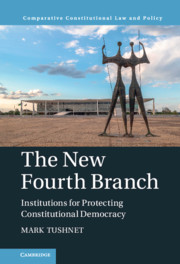Book contents
- The New Fourth Branch
- Comparative Constitutional Law and Policy
- The New Fourth Branch
- Copyright page
- Contents
- Acknowledgments
- 1 Introduction
- 2 Why a Fourth Branch?
- 3 Why a Fourth Branch?
- 4 Design Issues in General
- 5 Design Principles in Practice
- 6 Anti-corruption Investigations
- 7 Electoral Commissions
- 8 Audit Agencies
- 9 Conclusion
- Index
9 - Conclusion
Published online by Cambridge University Press: 20 August 2021
- The New Fourth Branch
- Comparative Constitutional Law and Policy
- The New Fourth Branch
- Copyright page
- Contents
- Acknowledgments
- 1 Introduction
- 2 Why a Fourth Branch?
- 3 Why a Fourth Branch?
- 4 Design Issues in General
- 5 Design Principles in Practice
- 6 Anti-corruption Investigations
- 7 Electoral Commissions
- 8 Audit Agencies
- 9 Conclusion
- Index
Summary
Contemporary constitutional design probably includes IPDs on the list of best practices. In a party-political world, which is to say, in today’s constitutional world, the case for creating IPDs to complement the traditional Montesquiean branches rests on seemingly cogent theoretical and functional arguments. Examining IPDs in design and operation, though, might lead to some troubling conclusions: that they don’t systematically improve the quality of constitutional democracy beyond the level generated by the traditional branches; that their functioning is so dependent upon local circumstances and contingencies that there are few lessons to be learned from them; that their performance may depend upon the overall party system within which they operate; and, troublingly, that they might work best in systems where they are least needed (those with stable competitive parties or dominant parties with stable programmatic factions) and even in those systems might actually weaken the Madisonian mechanisms of constitutional guardianship.
- Type
- Chapter
- Information
- The New Fourth BranchInstitutions for Protecting Constitutional Democracy, pp. 173 - 180Publisher: Cambridge University PressPrint publication year: 2021

